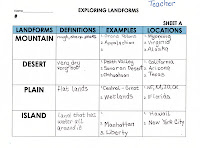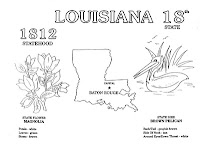At the end of the map project, you could have your students take a map quiz of their state. If age appropriate, it could be graded. http://www.enchantedlearning.com/usa/statesbw/oklahoma.shtml
http://www.enchantedlearning.com/geography/outlinemaps/usa.shtml
http://www.infoplease.com/atlas/unitedstates.html
http://www.50states.com/us.htm
http://www.kidzone.ws/geography/usa/
Have a variety of maps, resource books... for the students to be able to work independently.
OBSERVATION LESSON:
SAMPLE MAPS:
Lots of projects, actvities, and ideas. DOUBLE CLICK TO GET LARGE VIEW OR PRINT. Comments are welcome.
Friday, November 11, 2011
Wednesday, November 9, 2011
STATE-LANDFORMS
http://okscribbler.blogspot.com/2011/11/state-exploring-landforms-around-usa.html
http://okscribbler.blogspot.com/2011/11/state-5-sentence-landform-paragraph.html
http://www.worldatlas.com/webimage/countrys/namerica/usstates/usland.htm
http://en.wikipedia.org/wiki/Category:Landforms_of_the_United_States_by_state
TOURING THE U.S.A. BY PLANE.
http://www.youtube.com/watch_popup?v=KcuDdPo0WZk
http://okscribbler.blogspot.com/2011/11/state-5-sentence-landform-paragraph.html
http://www.worldatlas.com/webimage/countrys/namerica/usstates/usland.htm
http://en.wikipedia.org/wiki/Category:Landforms_of_the_United_States_by_state
TOURING THE U.S.A. BY PLANE.
http://www.youtube.com/watch_popup?v=KcuDdPo0WZk
Tuesday, November 8, 2011
STATE-FLOWER
Students draw or trace their state flower and then write a paragraph describing it. You can format a paragraph with information you want them to research.
http://en.wikipedia.org/wiki/List_of_U.S._state_flowers
http://www.50states.com/flower.htm
http://www.usna.usda.gov/Gardens/collections/statetreeflower.html
http://www.netstate.com/
http://www.kidzone.ws/geography/usa/
http://www.pickatrail.com/jupiter/location/north_america/usa/usa.html
http://en.wikipedia.org/wiki/List_of_U.S._state_flowers
http://www.50states.com/flower.htm
http://www.usna.usda.gov/Gardens/collections/statetreeflower.html
http://www.netstate.com/
http://www.kidzone.ws/geography/usa/
http://www.pickatrail.com/jupiter/location/north_america/usa/usa.html
Monday, November 7, 2011
Friday, November 4, 2011
STATE-LANDFORM WEBQUEST
Sorry, I cannot figure out how to get the web quest on this site for you to use. Here are the pages of the web quest. I would make a web quest and power point by starting with one I found on-line. I would find the one most appropriate for my grade level and then adapt it for the concepts I was required to teach.
Sheet A and writing paper for a USA Landform Essay: http://okscribbler.blogspot.com/2011/11/state-exploring-landforms-around-usa.html
Sheet B, Information about Volcanoes and Earthquakes along with quizzes that I used for Extra Credit Points: http://okscribbler.blogspot.com/2011/11/landform-compare-contrast-volcano-and.html
Sheet C and formatted 5 sentence paragraph to help students with their project requirements. http://okscribbler.blogspot.com/2011/11/state-5-sentence-landform-paragraph.html
Sheet B, Information about Volcanoes and Earthquakes along with quizzes that I used for Extra Credit Points: http://okscribbler.blogspot.com/2011/11/landform-compare-contrast-volcano-and.html
Sheet C and formatted 5 sentence paragraph to help students with their project requirements. http://okscribbler.blogspot.com/2011/11/state-5-sentence-landform-paragraph.html
Thursday, November 3, 2011
STATE-LISTING SOURCES
BIBLIOGRAPHY
Tips
• The book or magazine title is always underlined in a bibliography!
• If a citation is more than one line long, indent the second line five spaces.
• Put the bibliography in alphabetical order, by the author’s last name. If there is no author listed, use the first word of the title (not “a,” “an,” or “the”).
• When there is more than one author, list the authors in the order they are listed on the title page.
• If you use information from an article in a book or magazine, the article is listed before the title.
• The book or magazine title is always underlined in a bibliography!
• If a citation is more than one line long, indent the second line five spaces.
• Put the bibliography in alphabetical order, by the author’s last name. If there is no author listed, use the first word of the title (not “a,” “an,” or “the”).
• When there is more than one author, list the authors in the order they are listed on the title page.
• If you use information from an article in a book or magazine, the article is listed before the title.
Book with one author:
Higham, Cindy. Snowflakes for All Seasons. Salt Lake City: Gibbs Smith,
Higham, Cindy. Snowflakes for All Seasons. Salt Lake City: Gibbs Smith,
2004.
The author is listed, last name first. The title is underlined. The city where the book is published is listed followed by a colon and the name of the publisher. The year the book is published is then listed followed by a period.
The author is listed, last name first. The title is underlined. The city where the book is published is listed followed by a colon and the name of the publisher. The year the book is published is then listed followed by a period.
Personal Interview
Smith, Jane. Personal interview. 10 Feb. 2007.
Encyclopedia
“Human Spaceflight.” Compton’s Encyclopedia. Volume 22. Chicago, Encyclopedia,
“Human Spaceflight.” Compton’s Encyclopedia. Volume 22. Chicago, Encyclopedia,
Britannica, 2004.
World Wide Web/Internet:
Australian Scientists Prove Less Trees, Less Rain. Online. 10 March 2005.
If there is an author, list it first. Title of item is underlined. [online]. Date of access and put the in brackets.
Australian Scientists Prove Less Trees, Less Rain. Online. 10 March 2005.
If there is an author, list it first. Title of item is underlined. [online]. Date of access and put the
Where to find the information:
Information for bibliographies is taken right from the source. Look at the title page for the publisher, city, and author. Copyright information is found on the verso page. Another good place to look is the computer catalog at the library.
Glossary:
biography --- A book written about a person’s life.
bibliography --- A list of materials used in creating a report or paper.
citation --- Source of information used in a report.
et al. --- “and others”
periodical --- Publication, especially magazine or newspaper that is printed in regular intervals.
place --- City where the publisher is located.
publisher --- The company that produces the material.
signed --- An article that has an author listed.
verso --- Opposite of the title page (the left page of a book).
Information for bibliographies is taken right from the source. Look at the title page for the publisher, city, and author. Copyright information is found on the verso page. Another good place to look is the computer catalog at the library.
Glossary:
biography --- A book written about a person’s life.
bibliography --- A list of materials used in creating a report or paper.
citation --- Source of information used in a report.
et al. --- “and others”
periodical --- Publication, especially magazine or newspaper that is printed in regular intervals.
place --- City where the publisher is located.
publisher --- The company that produces the material.
signed --- An article that has an author listed.
verso --- Opposite of the title page (the left page of a book).
Lawrence, Sharon and Crawford, Brian. How To Write a Bibliography. Online. 29 March 2007.
STATE-PROJECT INTRODUCTION
We will begin researching and writing our report during class time after ITBS Week. The New Mexico State Objectives we will cover in Social Studies and Language Arts are:
~ Locate ideas and information about social studies topics.
~ Construct visuals showing historical events in a state.
~ Plan a cultural appreciation event utilizing stories, food, music...etc. that recognize and
celebrate diverse cultures.
~ Identify varying landforms and geographic features as components of Earth's physical systems.
~ Listen to, read, react to, and retell information.
~ Locate and use a variety of resources to acquire information across the curriculum.
~ Demonstrate competence in speaking to convey information.
~ Apply grammatical and language usage conventions to communicate.
~ Demonstrate critical thinking skills to comprehend written, spoken, and visual information.
The Archdiocese of Santa Fe Concepts we will cover in Social Studies and Language Arts are:
`SS 1.2 Recognize major events that shaped the United States
`SS 1.3 Identify Americans, inventors, and other historical persons who have influenced
American History
`SS 1.4 Present a written and oral report on an historical event, person, and/or symbol significant to
our lives as Americans
`SS 1.7 Differentiate between, locate, and use primary and secondary sources
`SS 1.8 Use resources for historical information
`SS 1.9 Use effective communication skills and strategies to share research findings
`SS 1.10 Gather, organize, and interpret information using a variety of media and technology
`LA 1.21 Begin to summarize information
`LA 2.4 Construct a topic sentence as a starter for a paragraph
`LA 2.5 Write two to three support sentences for the topic sentence
`LA 2.8 Write a friendly letter
`LA 2.9 Self-edit for use of capitals and punctuation
`LA 3.6 Utilize encyclopedias as a source of information
Please spend the next few weeks helping your child collect resources to help answer questions that will be sent home weekly. The library has books on each state, you might write a relative in the state, or write to the Chamber of Commerce.
On-line resources that might prove helpful are:

















































